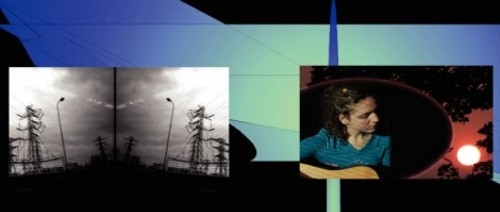Interplay: Event Horizon
Technically Speaking: After 25 years, Another Language is still the innovator of multidisciplinary art.
By Jacob StringerJimmy and Elizabeth (Beth) Miklavcic know this dilemma/dynamic all too well. For the past 25 years, their performing arts company, Another Language, has asked big questions while simultaneously utilizing innovative, often unproven technologies in creative new ways.
“Yeah, in one of our early pieces, the performers had headphones and cassette players attached to their belts which had instructions on what they were to do,” explains Beth. “For us, it was cutting edge at the time; of course, it sounds pretty traditional now.
“From there, we purposefully kept the concept open enough so that the fluidity of the technological changes would always be available to us, no matter how fast and grand those changes are.”
From such simple beginnings, Another Language has continually and exponentially expanded on the use of technology to explore artistic themes. Eight years ago, the whole venture took off to new heights with a series of projects called “InterPlays.” This year, for its silver anniversary, Another Language continues that exploration with a new work titled Event Horizon.
It’s a bit tricky to pin down what an InterPlay is. It involves multiple combinations and juxtapositions: different mediums and varying geographical locales; live and recorded elements; people with technology; information with art; music with spoken word. In Event Horizon, this translates into a multilayered digital mix of several live video streams set against several prerecorded video streams featuring music, movement and poetry. The live audience will also witness a live performance in the venue taking place in conjunction with the screened images.
The result is a visual collage of sorts that Another Language attempts to explain this way: “InterPlay is similar to the process that the brain performs during the formulation of a dream sequence. Images that have been stored through recent experiences simultaneously emerge in pieces, and the brain mixes them into a surreal sequence that loosely resembles a story. Video streams similar to these emerging images, coming from several sites across the country and the world, are then combined into a richly woven audio-visual tapestry.”
Although, to the Miklavcics, this kind of esoteric description makes perfect sense, they are also well aware of the disconnect that can occur between them and their audiences due to such random sequencing. They offer their groundbreaking use of technology in art over the years as a perfect example, explaining that it often results in a five-year delay before people understand their own personal use of the very same technology.
“A lot of the ideas that we had were always a step ahead of the technology and people’s use of that technology,” says Jimmy. “We’ve also done a lot of repurposing and adapting of technologies to make it do what we want it to do. So at times, we have been off on our own, waiting for both the people and technology to catch up. We may use what we call ‘real-time, distributed processes,’ but people are essentially doing the same thing when they text. Those are telematic-distributed communications. So, they are engaged in their own way; they may just not know it.”
As heady as all that may come across on paper, in person, the “audio-visual tapestry” that Another Language creates is both vivid and intriguing. It helps that the entire performance—including the technical crew magically making it all happen like wizards behind a curtain—intentionally and dramatically exhibits a kinetic grace similar to modern choreography.
Really, how could it be anything but? After 25 years, Another Language is comfortable gathering a wide range of influences into one giant collaborative process. For Event Horizon, the Miklavcics have brought together the likes of local musician Lexie Levitt, Los Angeles-based flautist Diane Hsu, Alaskan writer/actor Carrie Baker and the processed digital video of Miho Aoki from Tokyo, Japan. Beth will also provide digital imagery and background animation, while Jimmy will handle the live digital mixing during the actual performance.
If it all sounds precarious, that’s because it is. Yes, the key interest to creating both an InterPlay and experiencing one as an audience member is witnessing and being an active participant in celebrating how far technology has come. But the thing to remember is that although there just might be a hiccup in the connection between several video feeds, causing untimely delays and freeze-framed images, it all becomes celebrated as the fickle nature of technology—and the art it deftly inspires.
INTERPLAY: EVENT HORIZON
Intermountain Network & Scientific Computation Center at the University of Utah
155 S. 1452 East
March 26 – April 4
AnotherLanguage.org
Speaking of...
-
The Gadget Spot
Chatting with the four men behind the tech-driven podcast.
- Jul 3, 2016
-
Wine Wednesday: Fleming's WiNEPAD
- Jun 5, 2013
-
All About the Shakers
- Apr 27, 2012
- More »
More by Jacob Stringer
-
Slamdance 2014
After two decades, Slamdance is experienced in turning failure into fortune
- Jan 16, 2014
-
2013 Utah Beer Festival by The City Weekly Store
- Aug 20, 2013
-
Twilight Concert Series (7.18.13)
- Jul 24, 2013
- More »



